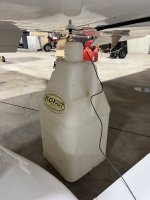JonJay
Well Known Member
Occasionally draining the tanks is necessary. I have done it with a variety of containers, elevated 5 gallon cans, funnels , etc….
Today, the chore was calibrating fuel level indication for a new EMS. Flofast has a system I have been using to fuel farm vehicles. They make various container sizes but I found the 7.5 gallon units fit perfectly under the RV6 drain. Made the job easier. There is a hand pump and hose that can drain the container in about a minute.
Today, the chore was calibrating fuel level indication for a new EMS. Flofast has a system I have been using to fuel farm vehicles. They make various container sizes but I found the 7.5 gallon units fit perfectly under the RV6 drain. Made the job easier. There is a hand pump and hose that can drain the container in about a minute.





